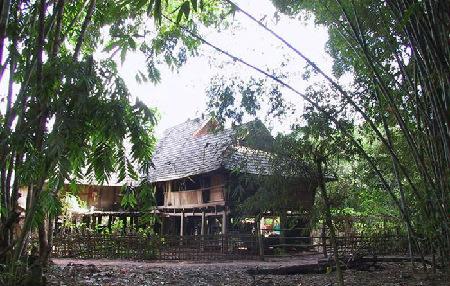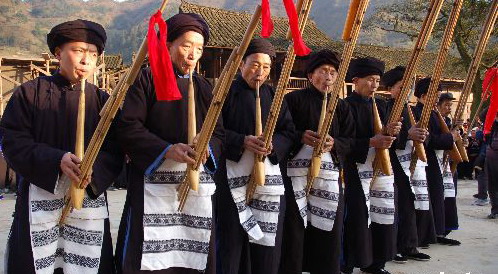Bamboo, a symbol of traditional Chinese values
Ages passed, and Emperor Shun did not return. His two wives, Ehuang and Nuying were worried about their husband. They decided to go to Hunan to look for Emperor Shun. They were told Emperor Shun died trying killing the dragons. At hearing the sad news, they cried tears of despair. The tears fell on the soil by the Xiangjiang River, and bamboo growing on the river bank was stained. There was something like fingerprints on the bamboo, and people said they are the fingerprints left by the two imperial concubines when wiping their tears. The red mottles on the bamboo came out from the blood of the tears.
2. Mengzong Bamboo
Mengzong, a scholar in ancient China, was a filial son who loved his mother so deeply that one of his stories was listed in the book of "24 Stories of Filial Piety" (the book keeps the records of 24 touching stories of filial people in ancient China).
During one winter, Mengzong’s mother was sick, and she wanted to eat some bamboo shoots. But usually bamboo didn’t grow shoots during winter, so Mengzong failed to find any bamboo shoots for his mother. He cried near the bamboo, and later he found some bamboo shoots at the places he cried. He took the bamboo shoots back home to cook for his mother. After eating the bamboo shoots, Mengzong’s mother became better gradually. People said the bamboo shoots came out because Mengzong’s filial piety had moved the heavens.
Bamboo and Characters
Bamboo formed the earliest ties with Chinese characters, which can be traced back to the New Stone Age 6,000 years ago. The pictographic symbol for "bamboo" was found on the pottery unearthed in the Yangshao cultural relics of Banpo Village, Xi'an in 1954, and the symbol was also discovered in oracle bone inscriptions and inscriptions on ancient bronze objects. Between the Warring States Period (475-221 BC) to the Jin Dynasty (265-420 AD), the people wrote on "bamboo slips". Many of the earliest Chinese historical documents, such as the Book of Story and The Book of Rites and Analects of Confucius, were recorded on such material,making great contributions to the development of Chinese culture.
Bamboo and Science and Technology
The application of bamboo in science and technology is really thrilling. The Chinese invented a bamboo drill dating back to the Shang Dynasty (1600-1100 BC). In 251 BC Li Bing, Sichuan prefecture, led the local people in building the Dujiang Weirs, the first irrigation network in the world, in which bamboo played an important role. The world's oldest water pipe was also made from bamboo. During the Han Dynasty (206 BC-220 AD) the Sichuan people successfully sank a 1,600-meter-deep well with thick bamboo ropes. This technology did not spread to Europe until the 19th century, and in 1859 the Americans drilled the first oil well in Pennsylvania by using the technology.
 |
Paper making is one of China's four ancient great inventions. In the Han Dynasty, people began to use bamboo to make paper, which was of excellent quality and reasonable price. Even now it is used as one of the important raw materials in paper making. Some of the xuan paper for traditional Chinese painting is also made from tender bamboo. The ancient Chinese people used bamboo chips for calculation before the invention of the abacus.
With the invention of gunpowder, the people wished to go into space. In the Yuan Dynasty (1279-1368) a man tied a big bamboo tube on each of the four legs of a chair and filled them with gunpowder. He wanted to send the person on the chair to space by reactive force after lighting the gunpowder. Although it seems somewhat absurd, no one can deny its value as the embryonic form of the earliest "manned rocket."
Bamboo and Architecture
Bamboo has been used in architectural art since long ago. During the Han Dynasty skilful craftsmen built a magnificent palace for Emperor Hanwudi with bamboo. In southern China where bamboo is abundant, bamboo stilt houses are common residences for the people. Today, some minorities in Southwest China, like the Dai people in Yunnan, still live in the two-storied bamboo stilt houses — the upper floor of the house contains bedrooms, kitchens and balconies, and the ground floor is used to house poultry and domestic animals. The bamboo houses set off by green plantain trees makes for a lovely picture.
 |
As it is light and tough with elasticity and bearing capacity, bamboo is an ideal building material, which can be used to construct houses, scaffolding and pillars. Enlightened by the Painting of Orchids and Bamboo, a masterpiece of the great Qing-dynasty painter and calligrapher Zheng Banqiao, Bei Luming,the world-famous architecture-design master, designed a 315-meter, 70-story mansion for China Bank. This magnificent building still stands lofty and firm in Hong Kong despite the horrible typhoons.
Bamboo and Music
Bamboo also has close ties with Chinese music. Among the cultural relics unearthed from the Zenghouyi tomb in Suixian County, Hubei Province, the 13-tube bamboo panpipe was the earliest one ever discovered. During the Tang Dynasty (618-907), musical performers were called zhuren (literally "bamboo people"), as most of the instruments were made of bamboo.
 |
Bamboo is indispensable to many traditional Chinese musical instruments, including the flute, sheng, zheng, jinghu, erhu and banhu. China's first national bamboo orchestra has a great variety of bamboo musical instruments, such as a dozen kinds of bamboo flutes, bamboo dippers, a bamboo percussion instrument composed of five or six drums of different sizes, and the huge dragon drum made of the world's thickest bamboo. When enjoying the pleasant music played by a buffalo boy with a bamboo flute, a love melody played by Miao young people with a lusheng, and some modern popular music played with bamboo musical instruments, one will be intoxicated with the purest sounds of nature.






















